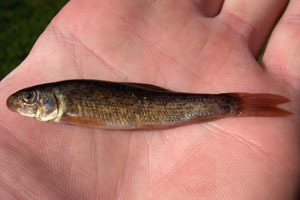|
April 19, 2016
Contact: Christian LeSage or Nick Popoff, 517-284-5830
Bait regulations changed to protect against fish disease and spread of invasive species

The Michigan Natural Resources Commission at its April 14 meeting approved fishing regulations that affect bait harvest and use. These regulations went into immediate effect.
Fisheries Order 245 establishes regulations that protect the aquatic resources of the state while minimizing the spread of pathogens, such as viral hemorrhagic septicemia (VHS) and aquatic invasive species, to uninfected waters. Special regulations listed in the order place restrictions on the minnow trade and anglers and where baitfish may be used.
In response to the discovery of VHS in Michigan waters of the Great Lakes, the DNR implemented in 2007 a comprehensive set of regulations. These regulations aimed at restricting the spread of VHS into disease-free waters affected recreational anglers, wholesale fish dealers, state-licensed commercial fishermen, private aquaculturists and retail bait outlets. Overall, these groups as well as the public have been accepting of the regulations and understand the importance of protecting the state’s fisheries.
All the changes are highlighted below and also are reflected in the online version of the 2016-2017 Michigan Fishing Guide, available at Michigan.gov/fishingguide. These regulation changes are part of Fisheries Order 245.
Fish Disease Regulations:
- All personally collected bait is required to be used on the same water in which it was collected.
- The state’s VHS-positive, surveillance and free management zones have been removed.
- The list of susceptible fish species has been updated and expanded.
- The restriction on the use of roe (fish eggs) in the exclusion zones has been removed, as fish eggs have not been documented moving VHS.
- All commercially harvested bait in November and December is required to be tested and certified as disease-free, as this time period represents 80 percent of the total annual minnow harvest in Michigan.
- A spring disease test is required for bait harvested in five zones of the Huron-Erie Corridor by the commercial bait industry to continue to monitor VHS.
For more information on viral hemorrhagic septicemia, visit Michigan.gov/vhs.
The Michigan Department of Natural Resources is committed to the conservation, protection, management, use and enjoyment of the state’s natural and cultural resources for current and future generations. For more information, go to www.michigan.gov/dnr.
|







